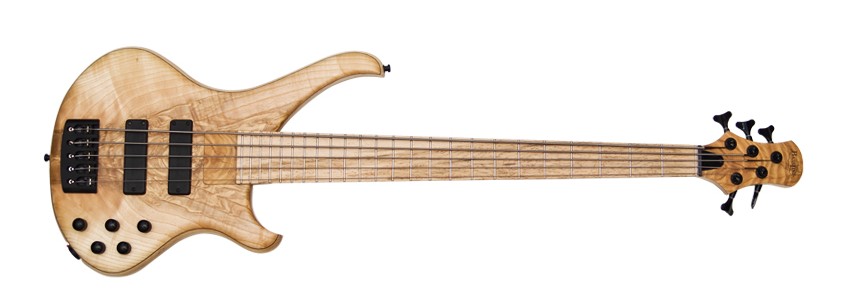The Buster is the most-wanted form of our Bassline product range. And there’s not just THE Buster but vast numbers of variations. On the one hand the form has changed in the course of years and on the other hand the used woods, hardware parts and also the detailed solutions have changed. The Buster is in a constant development and is always customized according to the customers‘ requests and musical tastes.
In 1993 the Buster was born as the first official Bassline model. With the models at that time the neck was glued into a neck pocket in a complex way. The extremely low string action made these models special.
With the Buster Ziesemann was one of the newcomers of the aspiring German makers of premium basses. The résumé of the first test in a professional musician’s magazine 8/1993 was: “Both basses represent the most modern standard of German bassmaking art (…) Made completely by hand both these precious instruments prove that outstanding quality does not have to cost more than 4000 DM”.
In 1995 the complex fixing of the neck was revised and from this time the Buster was made with a bolt-on neck. Kurandt delivered the electronics for the first basses, but from the late 90s up to today Klaus Noll has become our supplier and meanwhile Bassline has taken over sales and distribution for these parts.
The first form of the instrument today is called Buster Classic. It is still made with modern hardware and equipped with pickups, but in 1998 a more modest form was added. This new form impresses with its most ergonomic and pleasing shape as well as its delicate weight which can be ascribed to the use of Dibetou wood for the body.
The Buster of 1998 has indeed got a new design which stresses the simplicity of the lines and its inexpensiveness. The model with the bolt-on neck presents itself as a premium-quality working bass without knick-knacks, with a classy equipment and well made of precious woods.” (G&B 9/1998, Dirk Groll)
We still make the Buster Standard but preferably with a body made from ash and equipped with different pickups.
In 2006 the development of the Buster focuses on its appearance, an additional weight reduction and the sound shaping by a specific choice of woods. For the Buster CW (Custom-Wood) lightweight body woods such as swamp ash or mahagony are combined with hardwoods for the tops.
To reduce its weight the Buster is made with a “chambered” body. The shaped recesses are often covered with conspicuously grained cover woods.
„With its combination of woods the Buster offers an interesting sound mix of defined sound response and massive foundation” (G&B 4/2009, Dirk Groll)
The Buster CW in its fretless version has proved a long runner. The combination of the “Jazzbucker”-pickup by Harry Häussel and a special Bassline fretless electronics by Klaus Noll as well as specific wood compositions gives the instrument its required vigorous, wooden and purring sound aesthetics combined with an astoundingly light weight.
„This instrument is nearly perfect. If ever there is Mojo it can be felt with this instrument. I can testify soul, character and personality to this instrument – everything was put into it by its maker. (…)”(Bassquarterly / 2/2009, Lutz J. Mays)
With the introduction of the new pickups “The Xtender” by Delano in 2009 Ziesemann developed an embedded pickguard for the Buster CW in which the pickup is positioned. This changes not only the sound of the instrument but also most notably its appearance.
„This neat and pleasant five-string shows with its harmonious looks what to expect soundwise: here lively swing meets fine-tuned harmony. The wood construction with its strong resonance gives a lot of tail wind to the sound, the powerful Xtender pickup adds pressure and freshness in all frequency ranges and thus provides a substantial variability of sound. The Zebrano Buster finds the right balance in every respect, and a universally usable premium bass can hardly be better accomplished!” (G&B 2/2010, Dirk Groll)
Since 2008 with the BlackBuster Bassline has offered a series of Busters from classic to standard forms with a body of ash that are all equally equipped. These basses, equipped with a MM pickup by MEC and a Noll 3-band EQ, are very popular models because of the absolutely low budget calculation. For the moment they are produced exclusively in a open-pored black – but can be delivered in other colours or in a natural version, the so called “Albino”, on demand.
The high-end version of the Buster is called Buster Art. All basses of this kind have in common the excellent quality of the woods and hardware parts being used in combination with neck-through and high-gloss finish. These basses with their lovingly done fine-tuning show Ziesemann’s craftsmanship.
In principle every modification of the typical Buster forms is possible. Bassline has produced some custom-made Busters like the headless versions, a combination of classic and standard shaping as well as seven stringed Busters and those with a pickguard. There are no limits set to the customers‘ wishes and the statement “THE Buster does not exist” is emphasized.

